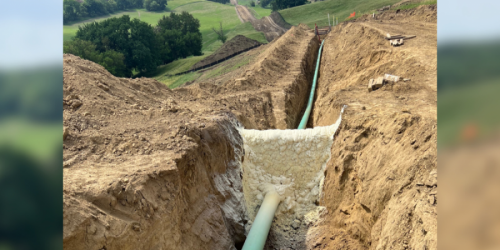Q&A Forums
SPF in existing homes and odor Post New Topic | Post Reply
| Author | Comments |
|---|---|
|
SPFer
Posted: Jan 11, 2013 08:08 AM
|
SPF in existing homes and odor
We do most our work in residential insulation. We end up spraying a fair amount of attics and crawlspaces while people are living in the homes. We have had some complaints about odor in the past. I always tell owners that SPF is not an odor free product, tell them they should leave the home for 48 hours and our contract has a statement that "we cannot assume liability for owner sensitivity to properly installed product". We also try to vent the attic during, and for 24 hours after installation.My take on SPF, owners and odor is that everyone smells differently. We sprayed one small kneewall on the 3rd floor of a house. The husband said he could smell it from the 1st floor. Both the wife and me could detect only a slight odor when we were actually in the kneewall. I do not think this guy was crazy or picky, I just think we was hyper-sensitive to the foam. This odor liability is one of the major drawbacks to this business, in my mind. How do you contractors deal with this? Any verbage in the contract? We are thinking about typing up a standard disclaimer that every owner needs to sign. Also, how do you deal with venting? How about attics with no windows? Thanks |
|
Circle-D
Posted: Jan 12, 2013 07:26 PM
|
As far as venting goes, we use a 12" blower that is rated at 2500+ CFM. We put it in the window, blowing out. I have 2 of these. If it is a big place we will put one blowing in and the other one sucking out.If there is no windows available we put it in the entrance to the space, sucking out, with a piece of poly duct run outside. We generally keep a 50' piece of duct right on 1 of the blowers. We will use whichever one works for that particular job. We generally get no complaints on the smell. Our contract says they must be out of the building unless equippped with proper respiritory protection. Of course they never pay attention, but at least they have been notified of the dangers. |
|
mason
Posted: Jan 13, 2013 08:08 PM
|
As Skip suggested, ventilate the space and try to separate the inhabited space from the attic and crawl space. Best way is tape and plastic and develop negative pressure in the attic. What the folks did who sprayed my attic was to attach a large duct hose to a squirrel cage type fan and run the hose out the 2nd story window. Worked great, no odors in the house at all during the application. But keep it going after the application so the fumes don't infiltrate the house. Some folks are hyper sensitive to chemical odors and could experience cold like symptoms from the catalyst odors. If the odors last longer than a week or so, then you might have an issue that needs attention. |
|
Mark Mouton
Posted: Jan 14, 2013 08:20 AM
|
Mason, you mentioned catalyst odors. Is this what causes the (amine type?)smell? Also, what could cause odors to be prolonged(in open cell)?The material I use has a fairly wide range of installation temps(120-160) according to the temperature of the substrate we're spraying against. Could the foam being installed at to low of a temperature cause it to not fully react and leave a lingering odor? or does this have anything to do with it? Also, are most open cell foams close in their recipe?, how wide is the install temperature range for different manufacturers open cell foams? If you would respond with some technicalities I would appreciate it. |
|
SprayFoamSupply.com
Posted: Jan 16, 2013 08:41 AM
|
The EPA put out some ventilation guidance if that helps. Check link at left. The better you vent while you are spraying, the less odors there will be when you are done. George |
|
mason
Posted: Jan 16, 2013 08:52 PM
|
Sprayfoam odors come from the catalyst in the foam. Lingering Open cell foam odors typically come from a poor mix or an off ratio mix. Yes, cold liquid can cause a poor mix, not off ratio just not mixed sufficiently. There are similar catalyst packages among the system houses but not typically the same. There are around a dozen different types of amine catalysts that can be used with sprayfoam. Each system house may use different ones for different foam formulas depending on the density, reacton prfofile desired and compatibility with the other componenets, Operating temperatures can also vary, I have observed foam formulas that react well at fairly low temperatures (around 110 degrees F on up to 150 degrees F. |





























